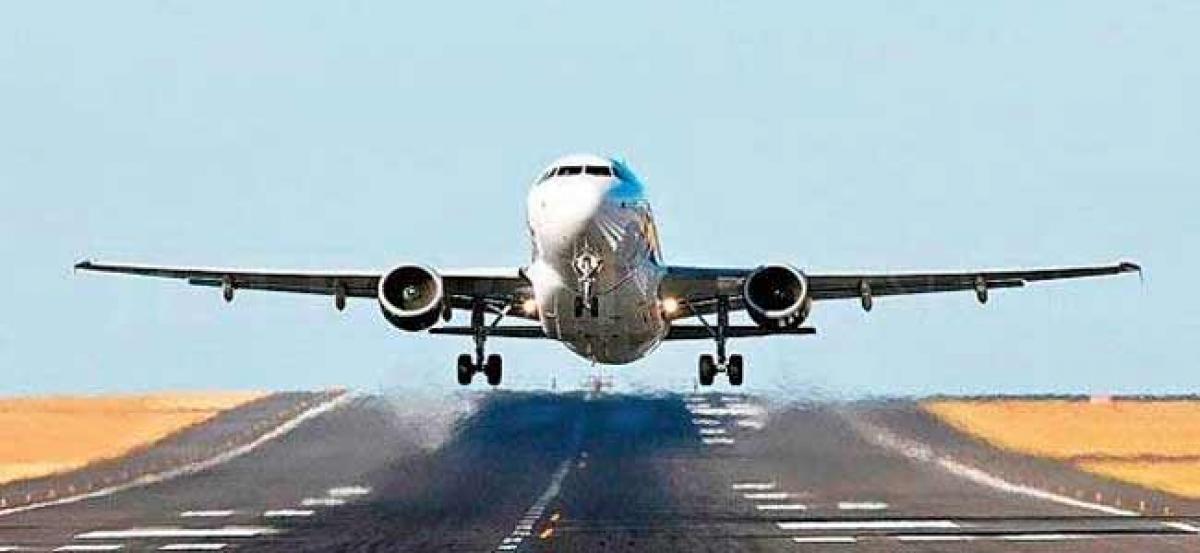Live
- ‘Get Set, Grow Summit 2024’ Focuses on Digital Detox for Families
- Stokes motivates his team to put in extra effort, says England pacer Potts
- From overcoming setbacks to leading India in U19 Women’s Asia Cup, Niki Prasad's amazing journey
- Driving Enterprise Security: Inside Venkata Reddy Thummala’s Leadership Journey
- Constitution debate: PM Modi hails 'Nari Shakti'; makes strong pitch for 'United Bharat’
- Abhijeet Bhardwaj: Revolutionizing Enterprise Analytics with Innovation and Expertise
- Bihar: Inquiry initiated against principal who went to buy veggies during school hours
- Press Sri Lankan Prez for release of Indian fishermen: TN Cong MP to EAM Jaishankar
- TN: DMK postpones executive meet due to heavy rains & Parliament session
- Porous silicon oxide electrodes can fix durability issues in batteries: Researchers
Just In

As a shutdown of Bali\'s airport is extended due to volcanic ash, airlines bracing for millions of dollars of lost revenue per day are scrambling to minimise damage by offering travel to other destinations and alternative transport off the island.
As a shutdown of Bali's airport is extended due to volcanic ash, airlines bracing for millions of dollars of lost revenue per day are scrambling to minimise damage by offering travel to other destinations and alternative transport off the island.
The airport on the Indonesian tourist island was closed for a second day on Tuesday because of ash from the eruption of the Mount Agung volcano, which has already disrupted several hundred flights and tens of thousands of passengers.
With no immediate sign of the eruption ending any time soon, industry experts say airlines may consider making longer-term flight frequency adjustments to Bali as forward bookings collapse and risks of ash damaging aircraft linger.
AirAsia will look to redeploy capacity elsewhere in its network, the airline group's chief executive Tony Fernandes tweeted on Tuesday, without providing details of any adjustment.
Most airlines are for now offering various options to minimise the short-term impact, preparing customers to expect scheduled disruptions until at least Dec. 4.
"If this situation is prolonged for 2 to 3 months, it is possible that the airlines could reduce their Bali flights in the upcoming northern summer schedule that starts from end-March," said Corrine Png, chief executive of transport research firm Crucial Perspective, although she said they would be wary of losing airport slots when demand eventually returned.
Australia's Jetstar is allowing passengers to re-route to other holiday destinations like Phuket in Thailand, while Singapore Airlines Ltd budget offshoot Scoot said it would transport stranded passengers by bus and ferry from Bali to the city of Surabaya on the neighbouring island of Java for flights back to Singapore.
Png said each day that the Bali airport was closed meant about $5 million in combined lost flight revenue for the 42 airlines that fly there.
"This comes at a bad time for the airlines as we are in peak travel season right now and the Bali route is highly lucrative," she said.
"Forward bookings to Bali will collapse as a result and the airlines will have to re-deploy their excess capacity to alternative destinations which are less profitable and may even have to discount more to fill up their planes."
Alicia Seah, an official at Singapore-based travel agency Dynasty Travel, said bookings and inquiries for travel to Bali had dropped by half in the past two months following warnings that the volcano could erupt.
"Those departing this week and early December are asking for diversion to Thailand, Vietnam and Cambodia and we are now assisting them to do that. But those departing mid- to late-December are adopting a wait-and-see attitude," Seah said.
FREQUENT ERUPTIONS
To be sure, volcanic activity is common in Indonesia and ash clouds have led to sporadic airport closures and cancellations of flights to and from Bali on at least six occasions over the last three years, often for days at a time.
But on those occasions, the volcano spewing ash was on a neighbouring island rather than Bali itself, making this a more serious threat to tourism.
Airlines avoid flying with volcanic ash in the air because it can cause significant damage to aircraft engines, clogging fuel and cooling systems, hampering pilot visibility and even causing engine failure.
In 1982, a British Airways 747 suffered severe damage and had all four engines flame out after flying through ash from Mount Galunggung in Indonesia.
Flight cancellations cost airlines in terms of refunds to passengers and paying fixed costs of aircraft and crew that are not flying, as well as for "relief" flights to return stranded travellers home.
Airline insurance usually covers physical damage to aircraft from ash but not the lost revenue, Png said.
In 2010, when a volcanic eruption in Iceland brought flights to, from and within much of Europe to a halt, the International Air Transport Association estimated airlines lost $1.7 billion in lost revenue in the first six days.
The ash cloud from the Bali volcano, however, is smaller and in an area far less frequented by major airline routes and it has for now been contained mostly to the airspace around Bali and neighbouring Lombok island, both of which are primarily tourist destinations rather than key business travel points.
The wind direction could change, pushing ash away from the airport.
An Indonesian disaster mitigation official said ash rose an estimated 20 km in 1963, during Agung's last major series of deadly eruptions that lasted about a year.

© 2024 Hyderabad Media House Limited/The Hans India. All rights reserved. Powered by hocalwire.com







